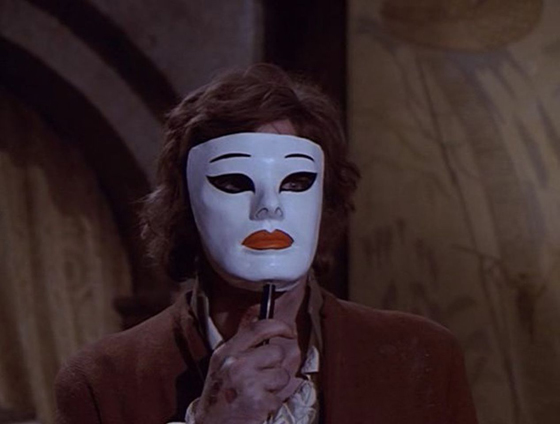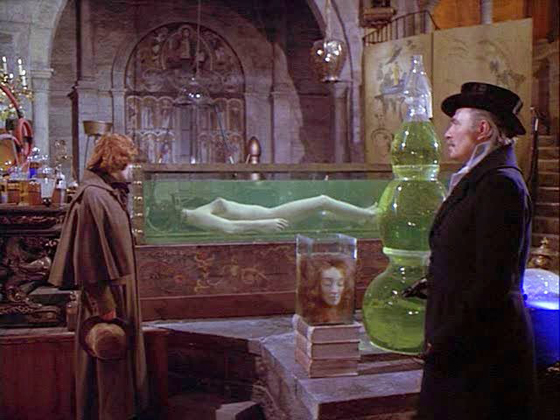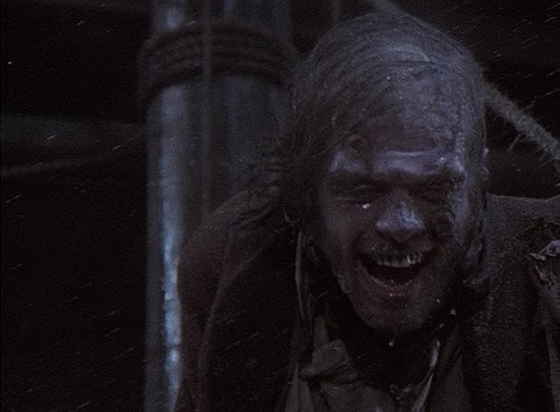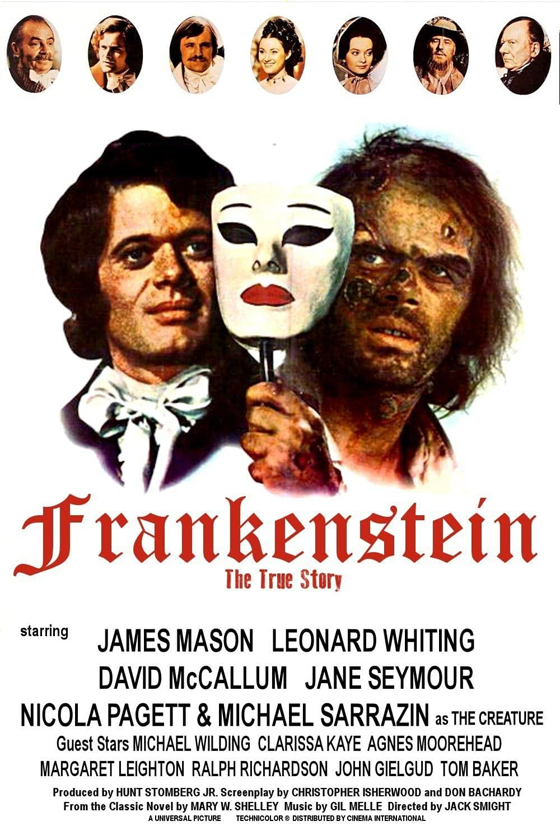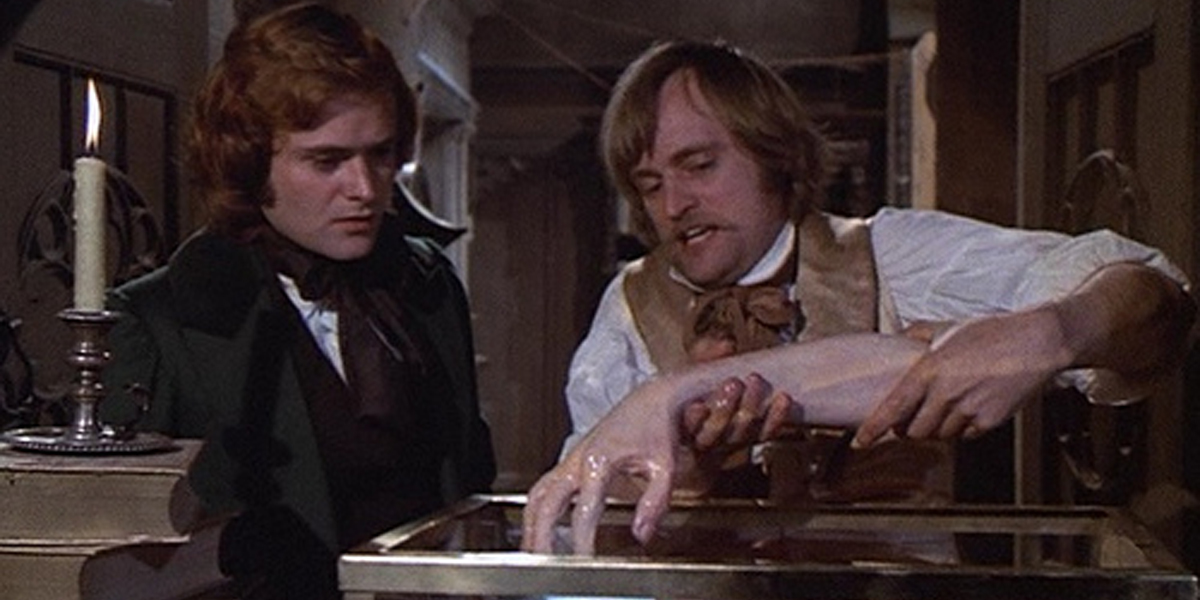
In 1973, the Good Doctor was just a 10-year-old intern, but already deeply absorbed in the world of horror and monsters. Quite a shock, eh? However, most of my monstrous interest revolved around the classic Universal horrors of the past, as well as a full slate of horror comics of all kinds. Frankenstein to me was Karloff’s flat-topped take on the Monster. At the point, I don’t think I had yet seen Hammer’s rather different version. I watched Night Gallery like a good little ghoul every week and tried to catch Outer Limits whenever it came on.
I very distinctly recall watching a two-part horror tale called Frankenstein: The True Story on NBC. This tragically unique reinterpretation of Mary Shelley’s iconic tale left a very deep mark on me, and I never forgot it even though it would be decades before I would see it again on DVD. It was a lavish version of the story and very graphic for its time, with some very gruesome scenes. James Mason’s superb portrayal of Dr. Polidori remains my favorite Mad Doctor of all time, which covers a HUGE amount of territory. But most of all, I remember a Monster which started out more like an angel. An angel that steadily became a monster and finally, a devil.
The title of Frankenstein: The True Story can be seen as an arrogant affront, considering that it changes quite a bit of Mary Shelley’s original. And yet, at its core, this version is perhaps the most faithful in terms of the tragic fall of young Victor Frankenstein. The subtitle of the original story was “The Modern Prometheus”. Prometheus pays dearly for his attempt to uplift mankind and so does Victor Frankenstein. Victor’s quest to defeat death winds up destroying not only himself but everybody around him. That tragedy is the very essence of what happens in Frankenstein: The True Story.
The movie was split into two 90-minute parts when it was first shown in 1973. On DVD, the two halves are joined into one film running slightly more than three hours. This running time, far greater than any other Frankenstein film, gave room for a lot of extra characterization and details. No expense was spared for the historical setting of the mid-1800s. The film equaled Hammer’s most lavish creations and outdid most of them.
The literate script was the creation of novelist Christopher Isherwood and longtime companion Don Bachardy. The movie was directed by journeyman Jack Smight and can likely be considered his best effort. As for the cast—no horror movie before or since has boasted such a talented crew. Leonard Whiting, who was Romeo in Zefferelli’s Romeo and Juliet, was brilliantly cast as young Victor Frankenstein. The aforementioned James Mason was superb as the suavely sinister Dr. Polidori. In fact, this is the role that made me a lifetime fan of the smooth-tongued Englishman. Also appearing were Michael Sarrazin as the Creature, David McCallum as Dr. Clerval, a ravishing young Jane Seymour as Prima, and Nicola Pagett as Victor’s wife, Elizabeth. John Gielgud, Ralph Richardson, Michael Wilding, Agnes Moorhead and Tom Baker also popped up in smaller roles.
With the background out of the way, let’s delve a bit deeper into Frankenstein: The True Story. Some spoilers lurk ahead so be forewarned….
It certainly doesn’t take long for tragedy to rear its ugly head. Handsome young scientist Victor Frankenstein is on a lakeside holiday with his young fiancée Elizabeth Fanshawe when Victor’s younger brother William drowns in a boating accident. The event serves as a catalyst for Victor. He leaves the funeral service for William in disgust when the preacher’s pious sermon offends him. “Why can’t I make life rise out of death?” he asks Elizabeth, who responds, “That’s how Satan tempted our Lord!”
“If Satan could show me how to bring William back to life, I’d gladly become his pupil!” Victor tells a shocked Elizabeth.
Satan soon arrives in the form of Prof. Henry Clerval (David McCallum), a disheveled and rudely arrogant scientist who nevertheless has a magnetic personality. He makes Victor’s acquaintance when he roughly saws off the arm of a farm boy involved in an accident. He manages to keep the amputated limb and brings it back to his laboratory. There, he shows an astonished Victor how he can use the power of the sun to bring a huge dead beetle back to life. After seeing this, Victor pledges to aid Clerval in his work, which soon takes him away from Elizabeth and his other duties.
When Clerval manages to bring the arm back to life, work begins in earnest. A tragic disaster in the mines kills a number of young workers. Clerval and Victor poke through the dead bodies as if they are on a shopping expedition, choosing one corpse for its legs, another for its arms, and one for its head. They plan to create a composite being which they will bring to life.
The day soon comes for the great experiment. But the night before, after Victor has left the lab, Clerval discovers with a shock that the disembodied arm they brought to life has deteriorated and become bestial in appearance. Clerval begins to write “the process is reversing itself” in his logbook when a massive heart attack strikes him down and kills him. When Victor finds the body in the morning, he makes the decision to go ahead with the experiment after he has performed one more operation. “No longer will our new man have the brain of a peasant,” he says, carrying Henry’s brain to the waiting subject.
One of the hallmarks of any decent Frankenstein film is the scene where the Creature is brought to life. This film is no different but takes a unique approach. The apparatus looks more authentic, like something that could have actually existed in the mid-1800s, complete with a giant bellows and a huge mirror. After a tense scene, the laboratory is torn apart by an explosion. When Victor wakes in the rubble, he sees the bandage-wrapped form of the Creature standing clear of the wreckage. He removes the bandages from its face…to reveal the angelic visage of a handsome young man.
“I feel you are William reborn,” an elated Victor tells the Creature. “Everywhere you go, you shall bring happiness.” The ultimate result is quite different.
The early days of the Creature’s life are filled with joy. He has the mind of a child and learns by imitating Victor’s lessons. Soon Victor feels confident enough to take the Creature out in society, with the cover story that he is a “foreign visitor”. The pair visit the opera and everyone is taken with the mysterious stranger, who loves music.
One night, though, Victor visits the ruins of the laboratory and hears a thumping sound. He opens the locked door where Clerval put the amputated arm. The arm falls out and crawls blindly on the floor. Victor is aghast…the arm has devolved terribly, becoming more hideous. In a repulsively authentic scene, Victor destroys the arm with acid. A terrible foreboding grips him. The feeling is justified when he notices a malformation of the Creature’s jawbone. The deterioration has begun.
The honeymoon with the Creature is over. Victor keeps him a virtual prisoner in his apartment, keeping him out of sight. The malformation is slight at first, but the Creature starts to take on an almost Neanderthal-like appearance. Victor’s attitude seems to deteriorate with the Creature’s looks and he snaps at it in anger. The Creature now reflects that anger in his own behavior. The dream has become a nightmare and when the Creature’s appearance causes the elderly housekeeper to suffer a stroke and die, things spiral out of control.
Finally, the child-like being sees its own ugliness in a broken mirror that distorts the image further and is overcome with rage and despair. It stabs itself in the chest over and over…to no effect. It then furiously runs out into the countryside, right up to the steep oceanside cliffs. Victor tries one more time to reason with it, but then lets it run over the cliff into the raging sea below. He believes the nightmare is over and the Creature is finally dead.
Of course, we know differently. A bedraggled and brutish Creature washes up on the beach and staggers into the nearby forest. Soon he encounters the blind old man Lacey (Ralph Richardson), who makes friends with him even though the Creature cannot speak. “You have an uncommonly strong hand, sir,” remarks Lacey. “And an uncommonly cold one as well.” The pair soon makes its way to Lacey’s cottage, where they have an idyllic scene that is clearly an updating of the classic “hermit” scene in Bride of Frankenstein. Lacey plays a mean fiddle and the Creature is delighted by his music.
But the old man is not alone. His beautiful daughter Agatha and her handsome boyfriend Felix come to visit him. The fearful Creature exits the cottage before they arrive, leaving a mystery for the young couple. The Creature secretly watches the group from the nearby woods and is fascinated by the gorgeous Agatha. And since she is played by 19-year-old Jane Seymour, I can’t say I blame him much.
Things fall to pieces when Felix discovers the malformed Creature visiting Lacey. He chooses to attack and the Creature fights back with superhuman strength, killing the young man and leaving poor blind Lacey in shock. Agatha flees up the country road in terror and is run over by an onrushing carriage, killing her. The traumatized Creature picks up her broken body and makes off into the woods.
Meanwhile, Victor has enjoyed something of a reprieve. He has put the episode with the Creature behind him and devotes himself utterly to Elizabeth. But on the very day of his wedding, a distinguished visitor demands to speak to him. This is the urbane but sinister Dr. Polidori (James Mason), who was Clerval’s mentor before the pair had a violent falling out. Polidori says he has a surprise guest who is eager to see Victor. Looking out the back window of Polidori’s ornate carriage is a face in a porcelain mask. The mask drops, revealing the now ugly Creature.
Victor is in shock and accompanies Polidori to the old lab where the Creature was brought to life. Polidori has completely rebuilt the structure and created his own laboratory. It seems that the Creature returned to the lab bearing Agatha’s body…returning home, as it were. Polidori is openly contemptuous of the Creature but believes he can use Agatha’s remains to create his own resurrected being using a completely different method than the one Henry and Victor used.
I can’t say enough about Mason’s performance as Polidori. He is full of peculiar quirks…his servants are all Chinese and his black gloved hands were ruined in an accident. He is completely unruffled by the Creature’s appearance and treats him almost like a stray dog. He’s full of arrogance yet his calm demeanor and articulate words speak of a great, twisted intelligence. He absolutely hates anything to do with Clerval’s theories, but he needs Victor’s sure hands to help him with the creation of a female creature. Victor adamantly refuses at first, but Polidori smoothly blackmails him into helping him. And he also says he can help “dispose” of Victor’s past mistake, the Creature.
In a weirdly beautiful and psychedelic scene, the nude form of the female Creature is brought to life in a tank filled with colored chemicals and bubbles. This was pretty racy for a TV show in the early 70s. Soon, Polidori’s creation comes to life…a beautiful young girl he calls Prima. The Creature is smitten by Prima and we can tell that he considers her a mate.
Before long, Prima and Polidori become part of the rarefied social circles that Victor and Elizabeth travel in. Polidori’s plans become clear…he wants to marry Prima to a powerful figure of the European aristocracy and then use her to gain political influence. A sullen Victor is revolted by his schemes and takes to the bottle. As for Prima, she charms almost everyone, but Elizabeth finds out that she has a twisted and almost sadistic soul. She catches her trying to strangle a cat and then sees her mocking Elizabeth’s own pregnancy. Prima may be physically beautiful, but her soul is even uglier than the Creature’s appearance.
Preparations are being made to solve Victor’s “problem.” A tank of highly corrosive acid has been constructed in Polidori’s lab. A master hypnotist, the Dr. mesmerizes the Creature and tells Victor to order him to lie down next to the tank. Even the unnatural Creature cannot withstand such acid. But at the very last second, Victor takes pity on his creation and yells “wake up!” The Creature awakens in a rage and soon one of Polidori’s Chinese henchmen is in the acid tank, which bursts apart. Polidori and Victor hurry upstairs and lock the Creature in the cellar. Polidori starts a fire and intends to burn down the entire building to destroy the Creature. His urbane control cracks and he yells, “Burn, traitor! Burn, Henry Clerval!” as the fire spreads. The house is reduced to ashes.
A couple of days later, there is a huge ball celebrating the marriage of Victor and Elizabeth. Many of the wealthiest and most powerful people in Europe are there. Polidori is delighted; many of the nobles are smitten with the gorgeous Prima. He will have his pick of rich fools to marry her. Disgusted, Victor drinks heavily.
Prima enchants all who see her…with the exception of Elizabeth, who is repulsed. As the crowd watches, the young girl dances beautifully in the grand ballroom. Suddenly, there is a disturbance as the great doors to the hall are thrust open. The Creature strides in before the appalled gathering. Before he was ugly, but now with the marks of the fire upon him, he is hideous. And there is also a change in his demeanor. The child-like innocent is gone now.
He sees Prima and murmurs “Agatha….” Surely here is a friendly face. But it’s not to be. Prima begins to hiss and snarl like a cat…she is preparing for battle. Suddenly some in the crowd realize that there are TWO uncanny beings in front of them. Prima lunges in fury at the Creature, who realizes she hates him. So, he fights back and the result is grotesquely horrible as Prima is torn apart. Polidori collapses in hysterics as the Creature walks up to Victor and says, “Beautiful, Victor…beautiful.”
The crowd has fled in disbelieving horror and The Creature also departs, leaving carnage in a space where minutes before music and gaiety prevailed.
The whole countryside is in an uproar after the debacle and Elizabeth uses all her family’s connections to keep Victor out of jail and the police from snooping around. The incident has been so traumatic that the couple will leave England entirely and take a ship to America in the hopes of starting a new life there.
There is no way for Victor to escape the consequences of what he has done. When he and Elizabeth board the ship to America, they find to their dismay that Dr. Polidori is also on board. He is determined that he and Victor will start their experiments anew in the New World. Elizabeth is completely repulsed by the sinister physician and begs Victor to stay away from him. But unknown to them all, another stowaway has joined them on their journey. The Creature, now looking utterly nightmarish, has smuggled himself onboard in a crate.
The voyage becomes a trip to Hell as the Creature makes his presence known and seems particularly driven to torment Polidori. During a dreadful storm, the Creature takes control of the ship, forcing the crew to depart. “It’s Old Nick himself!” yells one sailor as the cackling Creature is struck by lightning while in the mast and laughs it off.
The ship makes its way to the Arctic wastes, much as what happened in Shelley’s original novel. There, all the characters will meet their fate as Victor Frankenstein and his creation have their final reckoning. The last scenes stayed with me for more than 30 years until I finally picked up the DVD after years spent looking for a copy of this ground-breaking classic horror.
The original Frankenstein novel was typified by a feeling of relentlessly hurtling towards tragedy. In this one facet, Frankenstein: The True Story matches it perfectly. From the first scene of William drowning to the last confrontation between creator and creation, this story proceeds to doom.
The unique twist to “The True Story” is that the Creature starts out as physical perfection, with the innocence of a child. There are several hints during the film that Clerval’s brain and personality is still a part of the Creature, but they are fairly sparse. “The True Story” seems to be a comment on our society’s obsession with physical beauty and perfection. Once the Creature starts to lose his looks, Victor’s entire interaction with him changes, becoming tense and ultimately hostile, even though mentally the Creature is not overtly malevolent.
Dr. Polidori’s stinging rebuke to Victor sums up a lot of society’s feelings on beauty: “What a model parent you’ve been! You’ve loved your Creature as long as it was pretty, but when it lost its looks…hah! That was another matter. So much for your dainty conscience!”
Polidori’s own creature is Prima, who is a living example of how not to judge a book by its cover. She is almost inhumanly beautiful but utterly sociopathic, if not downright evil. When she rejects the advances of the Creature and strikes out at him, the once innocent being has lost its last chance for happiness. With his destruction of Prima, the Creature truly becomes monstrous and his ultimate vengeance on Polidori is horrific.
The writers Isherwood and Bachardy were an unabashedly gay couple in real life and executive producer Hunt Stromberg Jr. was also gay. One can certainly find homosexual subtexts throughout Frankenstein: The True Story but they are not overt. Certainly, when Victor and the Creature are enjoying their happy early days, there’s a hint of a relationship there, even though Victor is in love with Elizabeth. During the final ship voyage, Elizabeth and the Creature are instantly hostile to each other, perhaps recognizing a strange rivalry. These subtexts are subtle, but they are there if you look for them. Even the 1931 Frankenstein had such hints, considering James Whale was gay himself and maybe saw himself as a “monster” in more repressive times, as the superb film Gods and Monsters showed.
Beyond the universal themes which one can find in Frankenstein: The True Story, there is the simple enjoyment of a good story well told, with excellent performances even in small parts. The direction of Jack Smight never flags and harkens back to a time when period films could be done with lush attention to detail. Overall, the appeal of Frankenstein is the same as any great tragedy like Oedipus Rex or MacBeth. It’s a universal tale sadly lacking in these days of “found footage” and “jump scare” horrors. If you haven’t seen this one, I highly recommend it.


